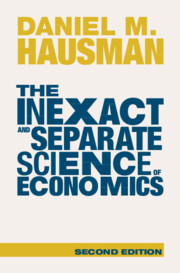Book contents
- The Inexact and Separate Science of Economics
- The Inexact and Separate Science of Economics
- Copyright page
- Contents
- Figures
- Tables
- Introduction
- Part I Introduction: Content, Structure, and Strategy of Mainstream Economics
- 1 Rationality, Preferences, and Utility Theory
- 2 Demand and Consumer Choice
- 3 The Theory of the Firm and General Equilibrium
- 4 Equilibrium Theory and Normative Economics
- 5 Equilibrium Theory and Macroeconomic Models
- 6 Models and Theories in Economics
- 7 The Structure and Strategy of Economics
- 8 Overlapping Generations
- Part II Theory Assessment
- Part III Conclusion
- Appendix An Introduction to Philosophy of Science
- References
- Index
1 - Rationality, Preferences, and Utility Theory
from Part I - Introduction: Content, Structure, and Strategy of Mainstream Economics
Published online by Cambridge University Press: 25 May 2023
- The Inexact and Separate Science of Economics
- The Inexact and Separate Science of Economics
- Copyright page
- Contents
- Figures
- Tables
- Introduction
- Part I Introduction: Content, Structure, and Strategy of Mainstream Economics
- 1 Rationality, Preferences, and Utility Theory
- 2 Demand and Consumer Choice
- 3 The Theory of the Firm and General Equilibrium
- 4 Equilibrium Theory and Normative Economics
- 5 Equilibrium Theory and Macroeconomic Models
- 6 Models and Theories in Economics
- 7 The Structure and Strategy of Economics
- 8 Overlapping Generations
- Part II Theory Assessment
- Part III Conclusion
- Appendix An Introduction to Philosophy of Science
- References
- Index
Summary
Mainstream economics portrays individual agents as choosing rationally. Many of its generalizations concerning how people actually choose are also claims about how agents ought rationally to choose. Chapter 1 focuses on the conception of rationality that is incorporated in contemporary economics and is central to it. It begins with the concept of preferences, which is the central concept in mainstream economics, and with the theory of rationality that focuses on preferences. The fact that a normative theory lies at the foundation of economics raises philosophical questions. What are requirements of rationality doing in what purports to be a scientific theory of economic phenomena? After presenting the axioms of ordinal utility theory, it offers an account of preferences, a critique of revealed preference theory, and an introduction to expected utility theory. It argues that if one wants to understand economics, the modeling of rationality is the place to begin.
Keywords
Information
- Type
- Chapter
- Information
- The Inexact and Separate Science of Economics , pp. 23 - 55Publisher: Cambridge University PressPrint publication year: 2023
Accessibility standard: Unknown
Why this information is here
This section outlines the accessibility features of this content - including support for screen readers, full keyboard navigation and high-contrast display options. This may not be relevant for you.Accessibility Information
- 1
- Cited by
